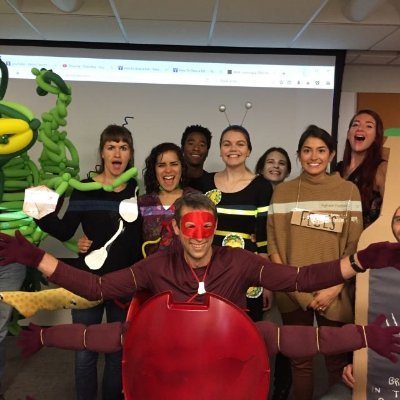
Sabrina Rondeau, PhD
@SabRondeau
Followers
646
Following
1K
Media
78
Statuses
581
🐝 Researcher | Postdoc at @uOttawa | Co-founder of @AbeillesCit_Qc | @ArrellFoodInst Scholar alumna | Entomology, ecology, agri-food, and bees!! (she/her)
Guelph, Ontario
Joined February 2018
🚨🐝 FUN SCIENCE ALERT! 🐝🚨Hibernating bumblebee queens can survive up to a WEEK underwater!! The discovery stems from an oversight leading to these tough little queens defying the odds, emerging alive after an accidental underwater stint! 🌊🐝 #FunScience #BumblebeeSuperheroes
Can #bumblebee queens endure periods of inundation while overwintering underground? New Biology Letters paper from Dr. @SabRondeau suggests that hibernating queens can survive up to 1 week submerged under water: https://t.co/hw2IFuhsWY
#OpenAccess #Pollinators @RSocPublishing
3
21
84
Huge congrats Dr @SabRondeau on winning the Ecology & Environment category of the Science & SciLifeLab Prize for Young Scientists. Read more about her impactful research in "Digging below the surface: hidden risks for ground-nesting #bees" https://t.co/e13EggnEoC
@ScienceMagazine
0
6
23
In this @ScienceMagazine essay, Sabrina Rondeau discusses her PhD research in @UofG_SES @UofGuelphOAC that reveals a clear potential for ground-dwelling bees to be affected by field-realistic (co)exposure to soil pesticide residues: https://t.co/FBHR8qApEn
0
6
9
#UofG | "One possible explanation is that the pesticides altered the soil properties and made it more appealing to the queen." Dr. Sabrina Rondeau discusses unusual bumblebee hibernation preferences with @Farmtario. @UofGuelphOAC @UofG_SES Read more:
farmtario.com
New research from the University of Guelph has found queen bees are more likely to hibernate in pesticide-contaminated soil.
1
4
8
L’automne est arrivé, les feuilles sont colorées et les citrouilles pollinisées par les #abeilles de la courge sont maintenant bien mûres dans les champs. En cette période de récolte, rappelons-nous de remercier les 🐝 pour leur importante contribution! 🎃🍂🍎
0
1
1
Dr. @SabRondeau’s new paper published in @SciTotEnv shows that #bumblebee (Bombus impatiens) queens prefer pesticide-contaminated soils when selecting underground hibernation sites: https://t.co/NxkVMVLYTO
#OpenAccess #Pollinators
1
11
35
Congratulations to Dr. Sabrina Rondeau for winning the 2023 CAGS-ProQuest Distinguished Dissertation Award in Engineering, Medical Sciences & Natural Sciences. 🙌 Register for the CAGS Conference to connect with Dr. Rondeau: https://t.co/Jns5B7V8r4
#GraduateEducation #PhD
1
2
5
Septembre est une période cruciale pour les #pollinisateurs. Les fleurs, comme la verge d'or, sont abondantes, permettant aux reines #bourdons d'accumuler les réserves de graisses dont elles auront besoin pour passer l'hiver. 🐝🌺🍂
1
1
3
🗞️ "Understanding and comparing relative pesticide risk among North American wild bees from their association with agriculture" ⤵️ @uofg @uOttawa With #NSERCsupport.
Recently published in @SciTotEnv w/@Squash_Bee : https://t.co/i7pzENBu48 This study is an attempt at characterizing and comparing #pesticide risk among North American wild #bee species from their association with agriculture. 🐝👩🌾🌽🚜🍎 🧵(1/4)
0
1
1
New paper led by @janean_sharkey reports 7 new #bee species records for 🇨🇦 from collections made in tallgrass prairie & oak savanna habitats in S. Ontario. Further evidence why studying & conserving #insects in these vulnerable habitats is so important: https://t.co/9mnCsdSXhG
0
12
34
(4/4) Most species facing the highest potential risk are ground-nesters. This suggests that species commonly proposed as models for #pesticide #RiskAssessments may not accurately represent risk for those bee species facing the highest potential risk in agricultural contexts.
0
0
2
(3/4) A sublist of 60 wild 🐝 species falling within the 90th percentile for Bee-Crop Risk Scores provides a representation of the species experiencing the highest potential pesticide risk from associating with crops across North America. ⚠️🐝🌽
1
0
2
(2/4) Using intrinsic 🐝 vulnerability traits and extrinsic factors like crop toxic loads and association strength, we calculated Bee-Crop Risk Scores for 594 wild bee species, identifying those experiencing the highest potential risk from pesticide exposure in NA agroecosystems.
1
0
2
Recently published in @SciTotEnv w/@Squash_Bee : https://t.co/i7pzENBu48 This study is an attempt at characterizing and comparing #pesticide risk among North American wild #bee species from their association with agriculture. 🐝👩🌾🌽🚜🍎 🧵(1/4)
2
5
18
Really looking forward to our @ice2024kyoto_jp symposium on #pesticide exposure & effects for insect #pollinators tomorrow. If you're in Kyoto @ #ICE2024 come along & hear @angelisanchez9 @jamesdcrall @simo_tosi @WilliamsBeeLab & many other fantastic speakers from 09:45 in Rm G
2
13
41
Important new paper investigating drivers of USA pollinator declines. Neonics and pyrethroids are the "winners"
Melissa Guzman, a 2021 fellow, just published her Liber Ero research on the impact of pesticide use on wild bee distribution! Check it out: https://t.co/Tpr7jsRJv0 and check out the USC press release:
0
1
9
Tandis que la plupart des 🐝 sont bien actives durant l’été à collecter du pollen pour nourrir leurs larves, certaines ne suivent pas cette routine! Les 🐝 coucous (#cleptoparasites) pondent leurs œufs dans d'autres nids, laissant leurs larves être nourries par d'autres espèces.
1
1
1
(5/5) Our results show that effects of pesticide exposure depend on intrinsic traits of bumblebee queen physiology and challenge our understanding of how bees respond to pesticides under environmentally realistic exposure scenarios.
0
2
10
(4/5) Exposure to cyantraniliprole led to lethal and sublethal post-hibernation effects that were dependent on queen size, with larger queens showing higher mortality rates, delayed emergence of their first brood, and producing smaller workers.
1
3
3
(3/5) We found that exposure to boscalid residues in soil doubled the likelihood of queens surviving through the colony initiation period (after successful hibernation) and laying eggs.
1
2
3
(2/5) We exposed Bombus impatiens queens (n = 303) to soil treated with field-realistic concentrations of two diamide insecticides (chlorantraniliprole and cyantraniliprole) and two fungicides (boscalid and difenoconazole), alone or combined, during a 30-week #hibernation period.
1
0
2









